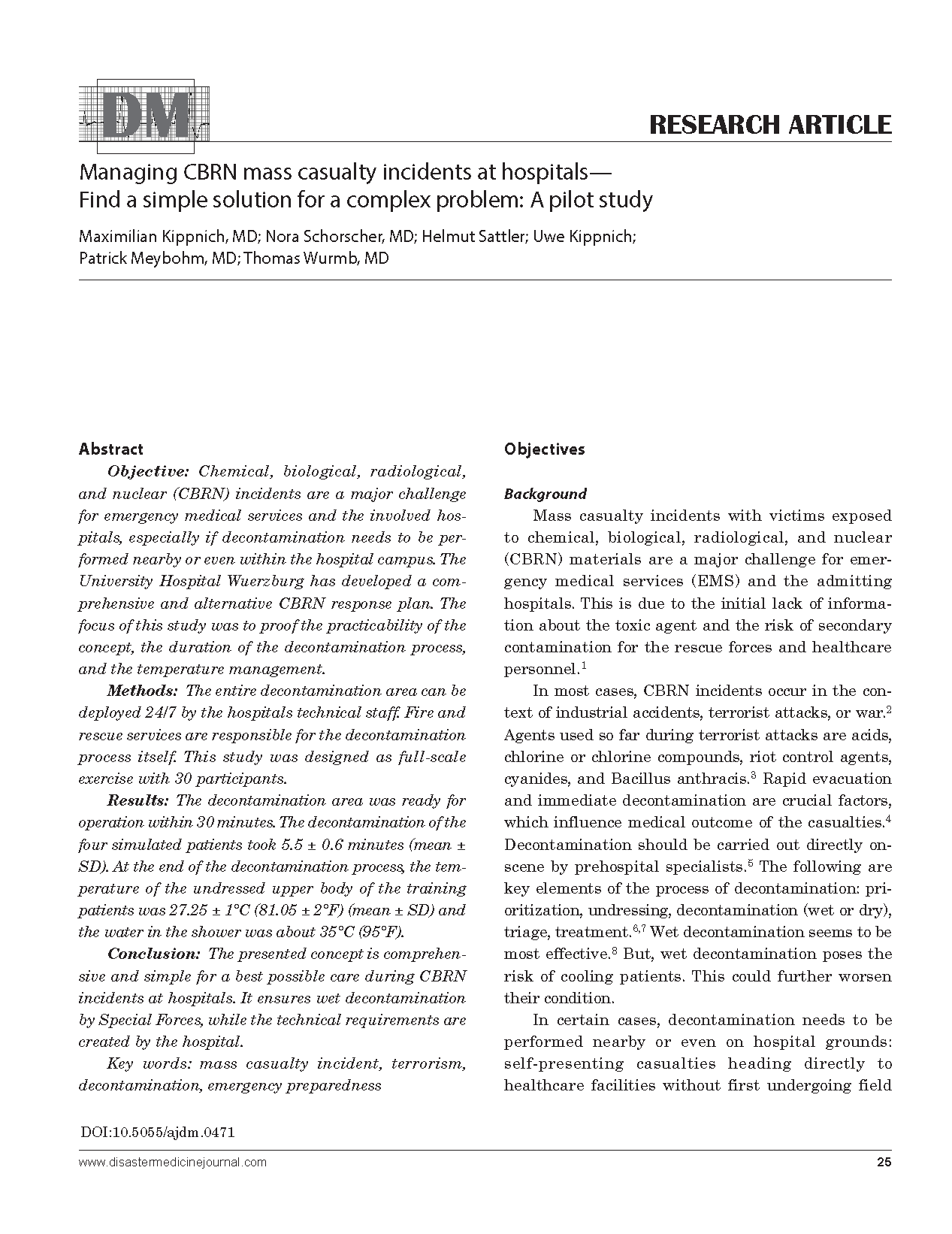Managing CBRN mass casualty incidents at hospitals—Find a simple solution for a complex problem: A pilot study
DOI:
https://doi.org/10.5055/ajdm.0471Keywords:
mass casualty incident, terrorism, decontamination, emergency preparednessAbstract
Objective: Chemical, biological, radiological, and nuclear (CBRN) incidents are a major challenge for emergency medical services and the involved hospitals, especially if decontamination needs to be performed nearby or even within the hospital campus. The University Hospital Wuerzburg has developed a comprehensive and alternative CBRN response plan. The focus of this study was to proof the practicability of the concept, the duration of the decontamination process, and the temperature management.
Methods: The entire decontamination area can be deployed 24/7 by the hospitals technical staff. Fire and rescue services are responsible for the decontamination process itself. This study was designed as full-scale exercise with 30 participants.
Results: The decontamination area was ready for operation within 30 minutes. The decontamination of the four simulated patients took 5.5 ± 0.6 minutes (mean ± SD). At the end of the decontamination process, the temperature of the undressed upper body of the training patients was 27.25 ± 1°C (81.05 ± 2°F) (mean ± SD) and the water in the shower was about 35°C (95°F).
Conclusion: The presented concept is comprehensive and simple for a best possible care during CBRN incidents at hospitals. It ensures wet decontamination by Special Forces, while the technical requirements are created by the hospital.
References
Titus E, Lemmer G, Slagley J, et al.: A review of CBRN topics related to military and civilian patient exposure and decontamination. Am J Disaster Med. 2019; 14(2): 137-149. DOI: https://doi.org/10.5055/ajdm.2019.0324
Baker D: Civilian exposure to toxic agents: Emergency medical response. Prehosp Disaster Med. 2004; 19(2): 174-178. DOI: https://doi.org/10.1017/S1049023X00001709
Aydin B: Global characteristics of chemical, biological, and radiological poison use in terrorist attacks. Prehosp Disaster Med. 2020; 35(3): 260-266. DOI: https://doi.org/10.1017/S1049023X20000394
Leary AD, Schwartz MD, Kirk MA, et al.: Evidence-based patient decontamination: An integral component of mass exposure chemical incident planning and response. Disaster Med Public Health Prep. 2014; 8(3): 260-266. DOI: https://doi.org/10.1017/dmp.2014.41
Power S, Symons C, Carter H, et al.: Mass casualty decontamination in the United States: An online survey of current practice. Health Secur. 2016; 14(4): 226-236. DOI: https://doi.org/10.1089/hs.2016.0047
Chilcott RP, Mitchell H, Matar H: Optimization of nonambulant mass casualty decontamination protocols as part of an initial or specialist operational response to chemical incidents. Prehosp Emerg Care. 2019; 23(1): 32-43. DOI: https://doi.org/10.1080/10903127.2018.1469705
Chilcott RP, Larner J, Matar H: UK’s initial operational response and specialist operational response to CBRN and HazMat incidents: A primer on decontamination protocols for healthcare professionals. Emerg Med J. 2019; 36(2): 515.2-515.23. DOI: https://doi.org/10.1136/emermed-2019-208798
Amlôt R, Carter H, Riddle L, et al.: Volunteer trials of a novel improvised dry decontamination protocol for use during mass casualty incidents as part of the UK’S initial operational response (IOR). PLoS One. 2017; 12(6): e0179309. DOI: https://doi.org/10.1371/journal.pone.0179309
Razak S, Hignett S, Barnes J: Emergency department response to chemical, biological, radiological, nuclear, and explosive events: A systematic review. Prehosp Disaster Med. 2018; 33(5): 543-549. DOI: https://doi.org/10.1017/S1049023X18000900
Koenig KL, Boatright CJ, Hancock JA, et al.: Health care facility-based decontamination of victims exposed to chemical, biological, and radiological materials. Am J Emerg Med. 2008; 26(1): 71-80. DOI: https://doi.org/10.1016/j.ajem.2007.07.004
Kako M, Hammad K, Mitani S, et al.: Existing approaches to chemical, biological, radiological, and nuclear (CBRN) education and training for health professionals: Findings from an integrative literature review. Prehosp Disaster Med. 2018; 33(2): 182-190. DOI: https://doi.org/10.1017/S1049023X18000043
Mortelmans LJM, Gaakeer MI, Dieltiens G, et al.: Are Dutch hospitals prepared for chemical, biological, or radionuclear incidents? A survey study. Prehosp Disaster Med. 2017; 32(5): 483-491. DOI: https://doi.org/10.1017/S1049023X17006513
Brizio A, Hubert J-C, Hennequin B, et al.: Swift and low-cost surge in chemical threat response: Is it possible? The experience of a French hospital. Disaster Med Public Health Prep. 2018; 12(5): 649-656. DOI: https://doi.org/10.1017/dmp.2017.119
Markel G, Krivoy A, Rotman E, et al.: Medical management of toxicological mass casualty events. Isr Med Assoc J. 2008; 10(11): 761-766.
Ahmadi Marzaleh M, Rezaee R, Rezaianzadeh A, et al.: Developing a model for hospitals’ emergency department preparedness in radiation and nuclear incidents and nuclear terrorism in Iran. Bull Emerg Trauma. 2019; 7(3): 300-306. DOI: https://doi.org/10.29252/beat-0703014
Larner J, Jones DR, Price SC, et al.: Modified static diffusion cells for decontamination modelling. Toxicology. 2010; 278(3): 351-352. DOI: https://doi.org/10.1016/j.tox.2010.08.099
Amlôt R, Larner J, Matar H, et al.: Comparative analysis of showering protocols for mass-casualty decontamination. Prehosp Disaster Med. 2010; 25(5): 435-439. DOI: https://doi.org/10.1017/S1049023X00008529
Chilcott RP, Larner J, Durrant A, et al.: Evaluation of US federal guidelines (primary response incident scene management [PRISM]) for mass decontamination of casualties during the initial operational response to a chemical incident. Ann Emerg Med. 2019; 73(6): 671-684. DOI: https://doi.org/10.1016/j.annemergmed.2018.06.042

Published
How to Cite
Issue
Section
License
Copyright 2007-2025, Weston Medical Publishing, LLC and American Journal of Disaster Medicine. All Rights Reserved.

